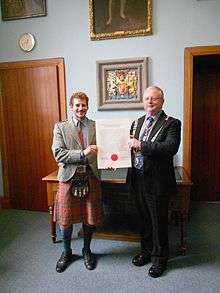Clan MacGillivray
| Clan MacGillivray | |||
|---|---|---|---|
 | |||
| Motto | Touch not this cat.[1] | ||
| War cry | Dunmaghlas.[1] | ||
| Profile | |||
| Plant badge | Boxwood (Latin: Buxus sempervirens) (Scottish Gaelic: Bocsa).[1] & Red Whortleberry (Latin: Vaccinium vitis-idaea) (Scottish Gaelic: Lus nam braoileag).[1] | ||
| Pipe music | "Loch Moidh" (Loch Moy)[2] | ||
| Clan MacGillivray has no chief, and is an armigerous clan | |||
| Historic seat | Dunmaglas[3] | ||
| |||
| |||
Clan MacGillivray is a Highland Scottish clan and is a member of the Chattan Confederation.[4] The clan does not currently have a chief; therefore, it is considered an Armigerous clan.[4]
History
Origins of the clan
The Clan MacGillivray was an important clan even before the Norsemen were driven out of the Outer Hebrides by king Somerled who was Lord of the Isles in the 12th century.[4] In 1222 Alexander II of Scotland subdued Argyll and the Clan Mhic Gillebrath became dispersed.[4] Some of the clan remained on the Isle of Mull while others stayed in Morvern.[4] There is a tradition that asserts that the chief of the clan placed himself under the protection of the chiefs of Clan Mackintosh, who were also chiefs of the Chattan Confederation.[4] Thereafter the Clan MacGillivray belonged to the Clan Chattan.[4]
16th to 17th centuries
.jpg)

The MacGillivray clan was first accurately recorded in Dunmaglass in 1549.[4] In 1609 there was a great gathering of the Chattan Confederation at which loyalties were given to the Mackintosh chief and the haill kin and race of Macgillivray was represented by Malcolm MacGillivray of Dalcrombie and Duncan MacGillivray of Dunmaglass.[4] The MacGillivrays were persecuted by their Calvinist and Presbyterian neighbors owing to their support of Episcopal polity of the church.[4]
18th century & Jacobite risings
Along with most of the other clans of the Chattan Confederation, the MacGillivrays were staunch Jacobites in both the Jacobite rising of 1715 and the Jacobite rising of 1745.[4] During the 1745 rising the chief of Mackintoshes and Clan Chattan was however a serving officer in the Black Watch regiment of the British Army but his wife, Lady Anne Farquharson-MacKintosh rallied the Chattan Confederation in support of the Jacobites and placed chief Alexander MacGillivray in command of the Clan Chattan regiment.[4] Alexander MacGillivray was killed leading his clan at the Battle of Culloden in 1746, along with many of his followers.[4] A graveyard at Dunlichity commemorates the many MacGillivrays who fell in the battle.[4] After Culloden many MacGillivrays emigrated across the Atlantic where many of them were successful, particularly as traders.[4]
Clan chief

The last chief to live at Dunmaglass was the 13th laird, Capt. John William MacGillivray, who had to sell his estate and died without an heir in 1914.[5] The chiefship then passed to a cousin of his, John Farquhar MacGillivray, who lived in Toronto, Ontario, Canada.[5] John Farquhar MacGillivray was chief for 32 years when he died in 1942 without an heir, and the last chief of Clan MacGillivray.[5] Another Canadian, Col. George B. Macgillivray, later petitioned Lord Lyon King of Arms three times between 1953 and 1989 to be recognised as chief.[5] Lord Lyon, not satisfied with the proofs Macgillivray submitted, denied him status of chief, but commissioned him as Commander of the Clan. Macgillivray served as Commander for five years before dying in 1994, and to this day the clan remains without a leader.[5][6]
In 2016 four Clan MacGillivary Societies of Scotland, America, Australia and the Netherlands elected Iain MacGillivray as Clan Commander[7][8]
Clan Castles
Dunmaglas which is about six miles east of Inverfarigaig in Inverness-shire was held by the MacGillivrays from at least the sixteenth century if not earlier.[3] Dalcrombie which is nearby was also held by the clan.[3]
Associated names
Clan MacGillivray does not have any septs, though common variations of the names MacGillivray and McGillivray, associated with the clan, are listed as follows.[9] Note that the prefix Mac/Mc are interchangeable, as well as the capitalisation of the second syllable.[9]
See also
Notes
- 1 2 3 4 The Clan MacGillivray Website Retrieved on 2007-10-12
- ↑ The Scottish clans and their tartans : with notes ([1900?]), Publisher: Edinburgh : W. & A.K. Johnston
- 1 2 3 Coventry, Martin. (2008). Castles of the Clans: The Strongholds and Seats of 750 Scottish Families and Clans. pp. 372. ISBN 978-1-899874-36-1.
- 1 2 3 4 5 6 7 8 9 10 11 12 13 14 15 Way, George and Squire, Romily. (1994). Collins Scottish Clan & Family Encyclopedia. (Foreword by The Rt Hon. The Earl of Elgin KT, Convenor, The Standing Council of Scottish Chiefs). pp. 422 - 423.
- 1 2 3 4 5 To Find a Chief Retrieved on 2007-11-11
- ↑ [A Dr Angus MacGillivary {d,1947} tried to claim the Chieftainship but was unable to prove his lineage-although he was awarded a variation of the Macgillivray coat of Arms in 1914. Possibly the Chieftainship lineage has not died out-Lachlan McGillivray {1718-1799}-the father of Alexander McGillivray and the great-uncle of William McIntosh and related to George Troup, is reported to have been of the Lineage Chiefs line.]
- ↑ Clan MacGillivary Australia website
- ↑ Clan MacGillivray Association of Canada wished Iain MacGillivray well as Clan Commander
- 1 2 3 4 5 6 7 8 9 10 11 12 13 14 15 16 17 18 19 20 21 22 23 24 25 26 27 28 29 30 Common Variants of "MacGillivray" & "McGillivray" Retrieved on 2007-10-12
External links
- The Clan MacGillivray Website
- http://www.electricscotland.com/webclans/m/macgill2.html
- Clan MacGillivray ScotClans